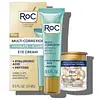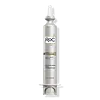What's inside
What's inside
 Key Ingredients
Key Ingredients

 Benefits
Benefits

 Concerns
Concerns

 Ingredients Side-by-side
Ingredients Side-by-side

Water
Skin ConditioningGlycerin
HumectantDimethicone
EmollientPropanediol
SolventCetyl PEG/PPG-10/1 Dimethicone
EmulsifyingSodium Hyaluronate
HumectantBis-PEG/PPG-14/14 Dimethicone
EmollientButylene Glycol
HumectantCaffeine
Skin ConditioningBiotin
AntiseborrhoeicPalmitoyl Tetrapeptide-7
Skin ConditioningMagnesium Aspartate
Skin ConditioningPalmitoyl Tripeptide-1
Skin ConditioningZinc Gluconate
Skin ConditioningChrysin
Skin ConditioningN-Hydroxysuccinimide
Skin ConditioningCopper Gluconate
Skin ConditioningSteareth-20
CleansingMethyl Methacrylate/Glycol Dimethacrylate Crosspolymer
Chlorhexidine Digluconate
AntimicrobialCaprylyl Glycol
EmollientChlorphenesin
AntimicrobialPotassium Sorbate
PreservativePhenoxyethanol
PreservativeSodium Chloride
MaskingSodium Citrate
BufferingCitric Acid
BufferingWater, Glycerin, Dimethicone, Propanediol, Cetyl PEG/PPG-10/1 Dimethicone, Sodium Hyaluronate, Bis-PEG/PPG-14/14 Dimethicone, Butylene Glycol, Caffeine, Biotin, Palmitoyl Tetrapeptide-7, Magnesium Aspartate, Palmitoyl Tripeptide-1, Zinc Gluconate, Chrysin, N-Hydroxysuccinimide, Copper Gluconate, Steareth-20, Methyl Methacrylate/Glycol Dimethacrylate Crosspolymer, Chlorhexidine Digluconate, Caprylyl Glycol, Chlorphenesin, Potassium Sorbate, Phenoxyethanol, Sodium Chloride, Sodium Citrate, Citric Acid
Water
Skin ConditioningPentaerythrityl Tetraethylhexanoate
EmollientGlycerin
HumectantPEG-8
HumectantPPG-15 Stearyl Ether
EmollientButylene Glycol
HumectantMaltodextrin
AbsorbentCyclohexasiloxane
EmollientStearyl Alcohol
EmollientCetearyl Alcohol
EmollientCeteareth-20
CleansingButyrospermum Parkii Butter
Skin ConditioningSwertia Chirata Leaf Extract
AstringentRetinol
Skin ConditioningHyaluronic Acid
HumectantSodium Hyaluronate
HumectantSodium Hyaluronate Crosspolymer
HumectantDihydroxy Methylchromone
AntioxidantAllantoin
Skin ConditioningAscorbic Acid
AntioxidantAscorbyl Palmitate
AntioxidantTocopheryl Acetate
AntioxidantPentylene Glycol
Skin ConditioningCaprylyl Glycol
EmollientC13-14 Isoparaffin
EmollientAllyl Methacrylates Crosspolymer
Emulsion StabilisingEthylhexyl Stearate
EmollientLaureth-7
EmulsifyingPolysorbate 20
EmulsifyingSodium Acryloyldimethyltaurate/Vp Crosspolymer
Emulsion StabilisingCyclopentasiloxane
EmollientPolyglyceryl-4 Diisostearate/Polyhydroxystearate/Sebacate
EmulsifyingSodium Isostearate
CleansingPropyl Gallate
AntioxidantChlorphenesin
AntimicrobialHydroxyphenyl Propamidobenzoic Acid
Skin ConditioningPolyacrylamide
Phenoxyethanol
PreservativeDisodium EDTA
BHT
AntioxidantSodium Hydroxide
BufferingWater, Pentaerythrityl Tetraethylhexanoate, Glycerin, PEG-8, PPG-15 Stearyl Ether, Butylene Glycol, Maltodextrin, Cyclohexasiloxane, Stearyl Alcohol, Cetearyl Alcohol, Ceteareth-20, Butyrospermum Parkii Butter, Swertia Chirata Leaf Extract, Retinol, Hyaluronic Acid, Sodium Hyaluronate, Sodium Hyaluronate Crosspolymer, Dihydroxy Methylchromone, Allantoin, Ascorbic Acid, Ascorbyl Palmitate, Tocopheryl Acetate, Pentylene Glycol, Caprylyl Glycol, C13-14 Isoparaffin, Allyl Methacrylates Crosspolymer, Ethylhexyl Stearate, Laureth-7, Polysorbate 20, Sodium Acryloyldimethyltaurate/Vp Crosspolymer, Cyclopentasiloxane, Polyglyceryl-4 Diisostearate/Polyhydroxystearate/Sebacate, Sodium Isostearate, Propyl Gallate, Chlorphenesin, Hydroxyphenyl Propamidobenzoic Acid, Polyacrylamide, Phenoxyethanol, Disodium EDTA, BHT, Sodium Hydroxide
Ingredients Explained
These ingredients are found in both products.
Ingredients higher up in an ingredient list are typically present in a larger amount.
Butylene Glycol (or BG) is used within cosmetic products for a few different reasons:
Overall, Butylene Glycol is a safe and well-rounded ingredient that works well with other ingredients.
Though this ingredient works well with most skin types, some people with sensitive skin may experience a reaction such as allergic rashes, closed comedones, or itchiness.
Learn more about Butylene GlycolCaprylyl Glycol is a humectant and emollient, meaning it attracts and preserves moisture.
It is a common ingredient in many products, especially those designed to hydrate skin. The primary benefits are retaining moisture, skin softening, and promoting a healthy skin barrier.
Though Caprylyl Glycol is an alcohol derived from fatty acids, it is not the kind that can dry out skin.
This ingredient is also used as a preservative to extend the life of products. It has slight antimicrobial properties.
Learn more about Caprylyl GlycolChlorphenesin is a synthetic preservative. It helps protect a product against bacteria in order to extend shelf life. In most cases, Chlorphenesin is paired with other preservatives such as phenoxyethanol and caprylyl glycol.
Chlorphenesin is a biocide. This means it is able to help fight the microorganisms on our skin. It is also able to fight odor-releasing bacteria.
Chlorphenesin is soluble in both water and glycerin.
Studies show Chlorphenesin is easily absorbed by our skin. You should speak with a skincare professional if you have concerns about using Chlorphenesin.
Learn more about ChlorphenesinGlycerin is already naturally found in your skin. It helps moisturize and protect your skin.
A study from 2016 found glycerin to be more effective as a humectant than AHAs and hyaluronic acid.
As a humectant, it helps the skin stay hydrated by pulling moisture to your skin. The low molecular weight of glycerin allows it to pull moisture into the deeper layers of your skin.
Hydrated skin improves your skin barrier; Your skin barrier helps protect against irritants and bacteria.
Glycerin has also been found to have antimicrobial and antiviral properties. Due to these properties, glycerin is often used in wound and burn treatments.
In cosmetics, glycerin is usually derived from plants such as soybean or palm. However, it can also be sourced from animals, such as tallow or animal fat.
This ingredient is organic, colorless, odorless, and non-toxic.
Glycerin is the name for this ingredient in American English. British English uses Glycerol/Glycerine.
Learn more about GlycerinPhenoxyethanol is a preservative that has germicide, antimicrobial, and aromatic properties. Studies show that phenoxyethanol can prevent microbial growth. By itself, it has a scent that is similar to that of a rose.
It's often used in formulations along with Caprylyl Glycol to preserve the shelf life of products.
Sodium Hyaluronate is hyaluronic acid's salt form. It is commonly derived from the sodium salt of hyaluronic acid.
Like hyaluronic acid, it is great at holding water and acts as a humectant. This makes it a great skin hydrating ingredient.
Sodium Hyaluronate is naturally occurring in our bodies and is mostly found in eye fluid and joints.
These are some other common types of Hyaluronic Acid:
Learn more about Sodium HyaluronateWater. It's the most common cosmetic ingredient of all. You'll usually see it at the top of ingredient lists, meaning that it makes up the largest part of the product.
So why is it so popular? Water most often acts as a solvent - this means that it helps dissolve other ingredients into the formulation.
You'll also recognize water as that liquid we all need to stay alive. If you see this, drink a glass of water. Stay hydrated!
Learn more about Water